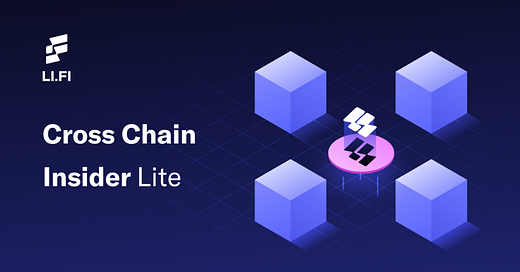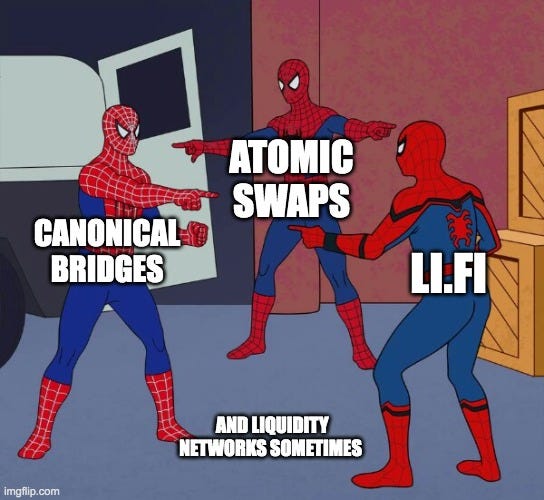One of the most confusing things about “bridging” (or swapping) assets is figuring out what type of token you get on the other side of the transaction.
In the most simplified way to explain this, there are really only two different types of tokens: native and non-native assets. This here essay was written to give you a brief overview of what these two different token types are.
What’s a Native Asset?
Native assets are defined as tokens deployed at the network or smart contract level of a blockchain. In essence, if an asset can be directly minted by a single entity on-chain without the help of a third party, then it is native.
So, for example, both ETH and AAVE are considered native assets to Ethereum as ETH is minted during every block and AAVE’s token was generated by a smart contract written by Aave developers. At a more complex level, USDC is native to Ethereum, Algorand, Solana, Stellar, TRON, Hedera, Avalanche, Flow, and Polygon, as Circle directly mints tokens to each chain after receiving dollars from customers.
Native assets can be easily swapped and transferred on their home blockchain, as there will be sufficient liquidity and the assets will match the blockchain’s protocol standards. However, native tokens cannot move to new chains due to differences in how protocols work (ex: Ethereum’s ERC-20 token standard isn’t compatible with Solana’s SPL token standard).
To move a native asset somewhere new, something must happen: a third party has to take that native token, change it in some way, and deposit it on the destination blockchain.
This brings us to the concept of non-native assets…
What’s a Non-Native Asset?
Non-native assets are defined as tokens that must be wrapped or validated by a third party before interacting with a blockchain.
Examples of non-native assets include wBTC, wMATIC, wSOL, etc – aka wrapped assets. These tokens exist on Ethereum but cannot be issued by the network or any smart contract on the network. Oftentimes, these tokens are created using the native asset as collateral to ensure 1:1 reserves. For example: for BTC to exist on Ethereum, wBTC was created, which is backed 1:1 by BTC off-chain.
Explaining this to Grandma
If I were going to explain native assets vs. non-native assets to my grandmother, I would say something like this:
Grandma, first of all, I love you.
Second of all, the concept of a native asset isn’t really all that complicated.
It’s exactly what it sounds like: a native asset is a token thingy that exists in its most natural form.
To put it in boomer (physical) terms, a native asset would be gold. Just straight up, hot and lumpy or cold and rectangular, gold.
A “non-native” asset would be like holding a receipt from the Royal Canadian Mint – which offers electronic tradable receipts (ETRs) backed by gold in their vaults.
Each has its strengths.
The raw gold is, well, gold and it has all the properties of gold: shinyness, durability, divisibility, whatever. The receipt from the Royal Canadian Mint isn’t gold – but it pretty much trades at the same price as gold and could be redeemed one for one if someone really wanted to do so. From there, and this is crucial, the receipt from RCM can be traded on the internet, making it easier to sell.
Now, why, Grandma, would anyone want a receipt of an asset rather than holding the asset?
Because, from a logical standpoint, gold is better than a receipt because gold is gold and a receipt is not gold.
The answer to that question, Grandma, resides in this thought experiment; what happens if you’re holding a bar of gold in Connecticut and you want to sell it to a friend in New Dehli? How can you sell the thing?
It’s hard as heck, right? So, what do you do? Well, the easiest way you could do this would be to hand off your gold bar to a middle man, like the Royal Canadian Mint, get a receipt for that gold, and send that receipt over the internet to your friend in New Dehli.
In essence, Grandma, the easiest way to move gold is to wrap it onto the internet.
And, well, Grandma, it’s the same things with blockchains.
Sometimes blockchains want to send native assets to each other, but can’t because it’s really hard for blockchains to communicate, just like it’s hard for humans to travel large distances with gold.
So, when a middleman, or a bridge, does something to a token to help it move from blockchainA to blockchainB, this asset is now considered “non-native.”
Why This Matters
Alright, let’s get a little technical (sorry Grandma).
For non-native assets, moving from ChainA to ChainB is really difficult due to the technical limitations of blockchains. To do so requires some sort of intermediary or validator set to translate transaction data from ChainA to ChainB. There are many types of ways “bridges” accomplish this task. Right now, the most popular way bridges work these days is via “lock and mint” mechanisms.
Generally, these bridges require a user to deposit a native asset into a bridge’s smart contract on the source chain, at which time the bridge mints a wrapped version of the asset to the destination chain. However, wrapped assets can struggle to achieve enough liquidity to be helpful and, importantly, if a user wants to bridge a wrapped asset again (thereby double wrapping it), very few DeFi protocols will accept a double wrapped. Furthermore, security can be an issue. For example, one question that should haunt all bridgeoooors is… what happens to a wrapped asset if the native chain goes down? (example haunting: Wormhole printing WETH on Solana and then Solana being halted)
Anyways, I guess you could say the rule of thumb is that it is almost always better to be holding native assets than non-native assets, as native assets have better liquidity and security than non-native assets.
Honestly, the dream is to receive a “native” asset in every bridging transaction. Meaning if you bridge USDC from Ethereum to Avalanche, you immediately receive the native Avalanche version of USDC, USDC.e. Or, if you want to do a token swap, then end result in a perfect world would be native asset for native asset.
So, how is this possible? What bridges can you use that where you start a native asset and leave with a native asset on the other end of the chain?
What To Do About It
For now, there are about three ways to trade in native assets:
Canonical Bridges
One way for “native” assets to transfer across chains is to have a single bridge be in charge of the minting of the asset across multiple chains.
For example, MakerDAO is pioneering a new solution for minting “native” DAI, its stablecoin, on multiple chains. Essentially, the protocol is proposing to control the issuance of DAI on new chains via the “Maker Bridge,” which will have the sole right to mint DAI on any chain against any collateral present on that chain – meaning DAI can now be “native” on chains like Solana, Avalanche, Fantom, etc.
Atomic Swaps
Atomic swaps are exchanges between two parties to trade tokens from two different blockchains. They allow users to trade native asset A for native asset B.
Atomic swaps are complicated, but, in summary, they are powered by a Hashed Timelock Contract (HTLC), which is a two-way virtual safe protected by math and constrained by time. If two users both put the correct amount of native tokens from their chains into the HTLC in the correct amount of time, then, voila, you get a cross-chain native token swap. THORChain is an example of an atomic swap-based protocol.
Author’s note: Liquidity networks like Stargate, Portal Bridge, and Connext also allow for native asset transfers, but only for assets that are native on multiple chains like USDC.
LI.FI
Another way to move from native asset to native asset is via a bridge and DEX aggregator like LI.FI. With transferto.xyz, a trading interface powered by LI.FI, a user can swap native asset for native asset quite easily – even though there is a bit happening on the back-end.
For example, via transferto, a user can turn 1 ETH into 1800 MATIC with the click of a button. On the backend, our smart contracts will route that transaction through a bridge and then swap it for MATIC on a DEX.
Conclusion
And that’s the blog post! The whole point of it is for you to be looking at a bridge whitepaper and understand what the heck it means when the protocol says it allows for the transfer of “native” assets.
If I missed anything (which I probably did), be sure to hit me up in the comments with critiques and additions. And, If you really liked this article, tweet it out :)
Fin.
Get Started with LI.FI Today
To learn more about us,
Head to our link portal at links.li.fi
Read our SDK ‘quick start’ at docs.li.fi
Join the official Discord server
Follow our Telegram Newsletter
or try our any-2-any swaps NOW at transferto.xyz









ETR - variant ccy- prepaid at purchase or contract time. u see my problem it decimates everything in iuts aptch. now ccy paid or swaps or rates defiend . and makes a mess of ten of any fiat ccy support model in palce bcos together they rise and togetehr they sink whne product and protocl and platform are all fungible and non fungible too. 2 aug 2022
asset or token or coin.. native versions. now also subordinate asset to overarching owned - and hten u say native non native. and why.. conversion or retention. mised a good few itesm have fun 2 aug 2022. is there an exchange or regualtor observer/penalisation mdoel or reward mdoels why ? why not?